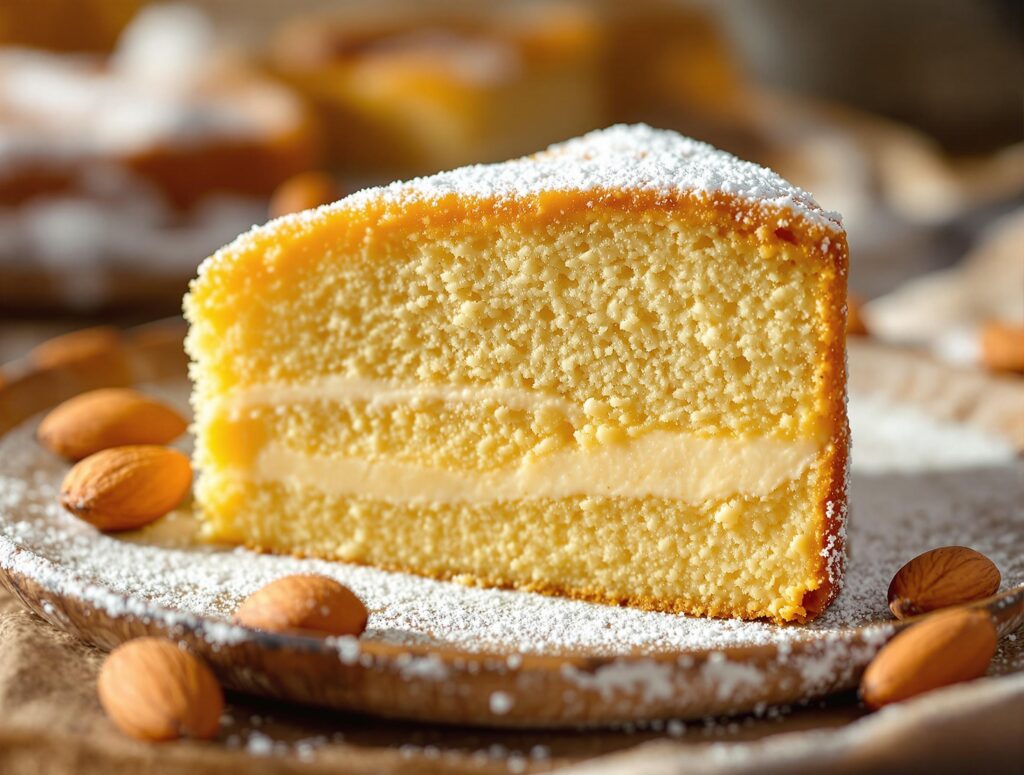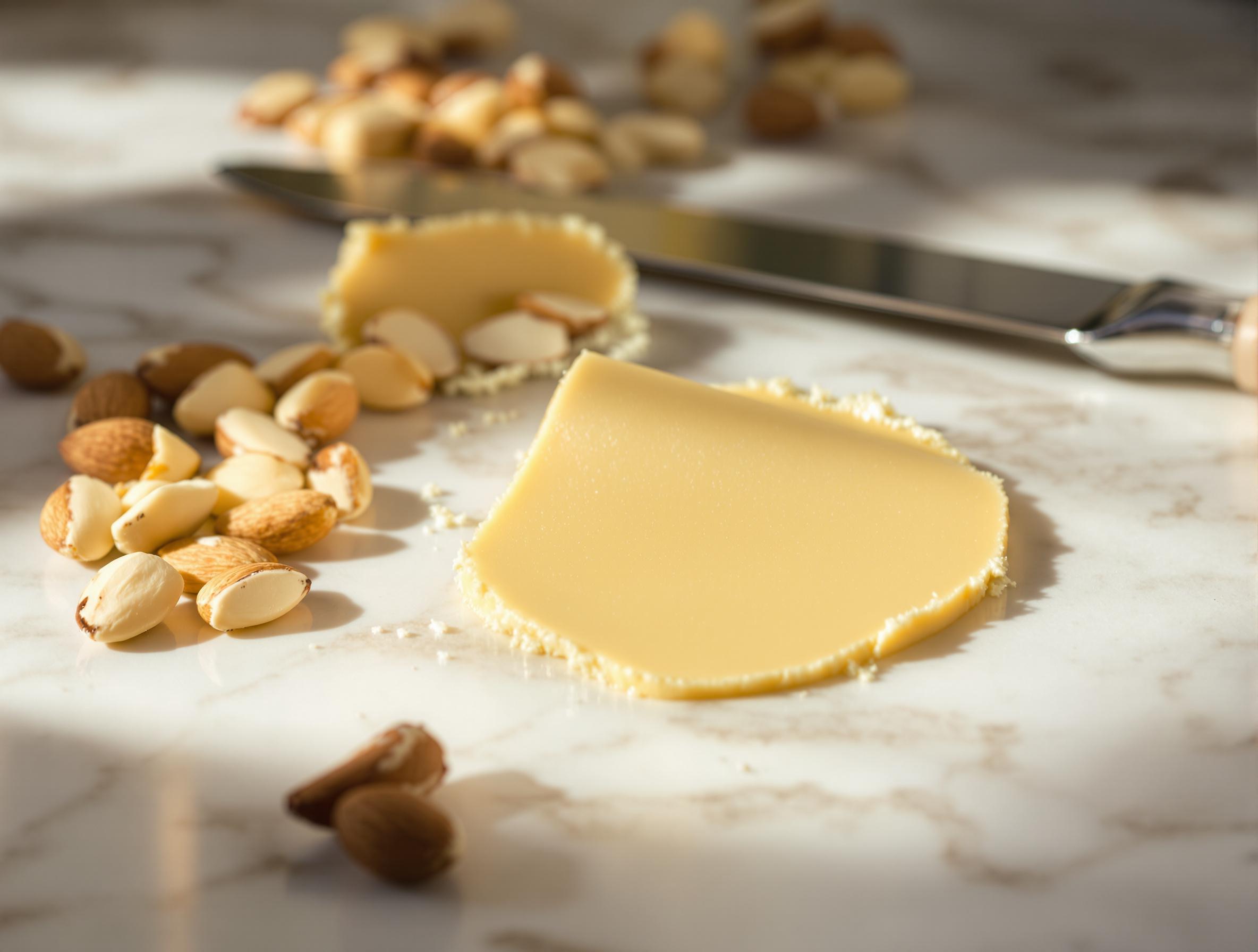Is almond paste the same as marzipan? If you’ve ever baked a dessert with almonds, you might have wondered about almond paste and marzipan. They both look similar, taste sweet, and are made from almonds. But are they the same thing? The answer is no! While almond paste and marzipan share some ingredients, they are quite different in taste, texture, and how they’re used in recipes.
Understanding these differences is important, especially if you want your dessert to turn out just right. In this article, we’ll explain what almond paste and marzipan are, how they’re made, and the key differences between them. By the end, you’ll know exactly which one to use for your next baking project!
Table of Contents
What Is Almond Paste?
Almond paste is a soft, sweet mixture made with ground almonds and sugar. It has a slightly grainy texture and a nutty flavor. Some recipes also include egg whites or almond extract to enhance the flavor. Bakers often use almond paste as a filling for pastries, tarts, and cookies.
Why Almond Paste Stands Out
Almond paste stands out for its versatility. Its balanced sweetness pairs well with other ingredients like fruits, chocolate, and spices. For example, you’ll find it in Danish pastries or as a layer in almond cakes.
How to Make Almond Paste
Making almond paste is straightforward and uses only a few simple steps:
- Blanch Almonds: Boil the almonds briefly, then peel off the skins to ensure a smooth texture.
- Grind Almonds: Grind the almonds into a fine powder.
- Mix Ingredients: Combine the ground almonds with sugar and, if desired, egg whites or almond extract.
- Form the Paste: Shape the mixture into a log or ball and store it in an airtight container to keep it fresh.
What Does Almond Paste Taste Like?
Almond paste has a strong almond flavor with a subtle sweetness. Unlike marzipan, it isn’t overly sugary, making it a great choice for recipes where you want the almond flavor to shine without overwhelming other ingredients.
Common Uses for Almond Paste
Almond paste is a popular ingredient in many desserts. Here are a few examples:
- Pastries: Use it to fill almond croissants or frangipane tarts.
- Cakes: Add it to cakes for extra moisture and a rich almond flavor.
- Cookies: Try it in traditional cookies like Italian almond biscuits or festive holiday treats.
What Is Marzipan?
Marzipan is a sweet and smooth mixture made from ground almonds, sugar, and sometimes egg whites or corn syrup. Its soft and pliable texture makes it perfect for shaping and molding. People often use marzipan to create edible decorations for cakes or to shape it into candies and figures like fruits or animals.
How to Make Marzipan
The process for making marzipan uses more sugar than almond paste, which gives it its unique sweetness and smooth consistency. Here’s how it’s prepared:
- Blanch Almonds: Boil the almonds briefly and peel off their skins.
- Grind Almonds with Sugar: Blend the almonds and sugar until the mixture becomes fine and uniform.
- Combine Ingredients: Mix in egg whites or syrup to form a smooth dough.
- Knead the Mixture: Work the dough by hand until it becomes soft and easy to mold.
What Marzipan Tastes Like
Marzipan tastes sweeter than almond paste because it contains more sugar. Its almond flavor is rich and pairs well with its sugary finish. This makes it a treat on its own or an excellent decorative element in desserts.

Common Uses for Marzipan
Marzipan plays a key role in baking and candy-making due to its smooth texture and versatility. Here’s how people commonly use it:
- Decorate Cakes: Use marzipan to cover cakes, like fruitcakes or Christmas cakes, for a polished look.
- Create Candies: Shape marzipan into small candies or figures like fruits and animals.
- Stuff Desserts: Add it as a filling to chocolates or pastries for a sweet surprise.
Its sweet flavor and moldable nature make marzipan a go-to choice for creating festive and eye-catching treats.
What Is Almond Paste?
Almond paste is a soft, sweet mixture made with ground almonds and sugar. It has a slightly grainy texture and a nutty flavor. Some recipes also include egg whites or almond extract to enhance the flavor. Bakers often use almond paste as a filling for pastries, tarts, and cookies.
Almond paste stands out for its versatility. Its balanced sweetness pairs well with other ingredients like fruits, chocolate, and spices. For example, you’ll find it in Danish pastries or as a layer in almond cakes.
How to Make Almond Paste
Making almond paste is straightforward and uses only a few simple steps:
- Blanch Almonds: Boil the almonds briefly, then peel off the skins to ensure a smooth texture.
- Grind Almonds: Grind the almonds into a fine powder.
- Mix Ingredients: Combine the ground almonds with sugar and, if desired, egg whites or almond extract.
- Form the Paste: Shape the mixture into a log or ball and store it in an airtight container to keep it fresh.
What Almond Paste Tastes Like
Almond paste has a strong almond flavor with a subtle sweetness. Unlike marzipan, it isn’t overly sugary, making it a great choice for recipes where you want the almond flavor to shine without overwhelming other ingredients.
Common Uses for Almond Paste
Almond paste is a popular ingredient in many desserts. Here are a few examples:
- Pastries: Use it to fill almond croissants or frangipane tarts.
- Cakes: Add it to cakes for extra moisture and a rich almond flavor.
- Cookies: Try it in traditional cookies like Italian almond biscuits or festive holiday treats.
Almond paste is an excellent choice for desserts that need a nutty flavor with just the right amount of sweetness.

Key Differences Between Almond Paste and Marzipan
Although almond paste and marzipan are made from similar ingredients, they have distinct differences that affect their texture, flavor, and uses. Here’s a closer look at how they compare:
1. Sweetness
The first major difference is sweetness. Marzipan contains much more sugar than almond paste, making it noticeably sweeter. Almond paste has a milder sweetness, which allows the almond flavor to take center stage.
2. Texture
Texture is another key factor. Almond paste has a coarse, grainy texture because of the ground almonds. This texture makes it ideal for fillings in pastries and baked goods. Marzipan, on the other hand, is smooth and pliable, perfect for rolling, molding, or shaping into decorations.
3. Common Uses
Each product serves a unique purpose in baking and confectionery:
- Almond Paste: Often used inside pastries, cakes, and cookies as a filling. It blends well with other ingredients to add moisture and flavor.
- Marzipan: Commonly used to cover cakes or create edible decorations like flowers, fruits, or festive shapes. It’s also eaten on its own as a candy.
4. Sugar-to-Almond Ratio
The sugar-to-almond ratio is significantly different in both. Marzipan has more sugar than almonds, while almond paste usually contains more almonds than sugar. This difference impacts both taste and how they are used in recipes.
5. Versatility
Marzipan is better for creating artistic and decorative elements due to its smooth and moldable nature. Almond paste, with its rougher texture, is better suited for recipes where it can be mixed or baked into the dish.
Why These Differences Matter
Choosing between almond paste and marzipan depends on your recipe. If you need something sweet for cake decorations or candies, marzipan is the way to go. If your recipe calls for a flavorful, nutty filling, almond paste will work best.
You Might Also Like
- Lemon Brownies – A tangy twist on the classic brownie, perfect for citrus lovers.
- Pancakes – Fluffy, golden, and easy to make for a perfect breakfast.
- Easy Triple Berry Crumble with Oats – A quick dessert bursting with berries and topped with a crunchy oat layer.
- If you want to try making almond paste yourself, check out this easy guide for homemade almond paste.
FAQ
1. Are almond paste and marzipan gluten-free?
Yes, both almond paste and marzipan are naturally gluten-free because they are made from almonds and sugar. However, always check the ingredient labels to make sure no gluten-containing additives were used in the product.
2. Can I eat almond paste raw?
Yes, you can eat almond paste raw. It’s safe and delicious, especially when added to desserts or eaten on its own as a sweet treat.
3. Why is marzipan sweeter than almond paste?
Marzipan contains more sugar than almond paste, giving it a sweeter taste and smoother texture. The high sugar content also makes marzipan better for decorative purposes.
4. Can I freeze almond paste or marzipan?
Yes, both almond paste and marzipan can be frozen. Wrap them tightly in plastic wrap and place them in an airtight container. They can stay fresh for up to six months in the freezer.
5. Are almond paste and marzipan the same as frangipane?
No, they are not the same. Frangipane is a creamy almond-based filling made with almond paste, butter, eggs, and sugar. It’s typically used in tarts and other baked goods.
6. Which is better for cake decorations: almond paste or marzipan?
Marzipan is better for cake decorations because of its smooth and moldable texture. Almond paste, with its coarse texture, is best used as a filling or ingredient in baked goods.
Conclusion
Almond paste and marzipan might look similar, but they serve different purposes in the kitchen. Almond paste is less sweet and coarser, making it perfect for fillings in pastries, cakes, and cookies. Marzipan, on the other hand, is sweet, smooth, and pliable, making it ideal for edible decorations and candies.
Knowing the differences between these two almond-based treats helps you choose the right one for your recipe. Whether you’re baking a cake, crafting edible decorations, or making a sweet filling, almond paste and marzipan both bring unique flavors and textures to your creations.

